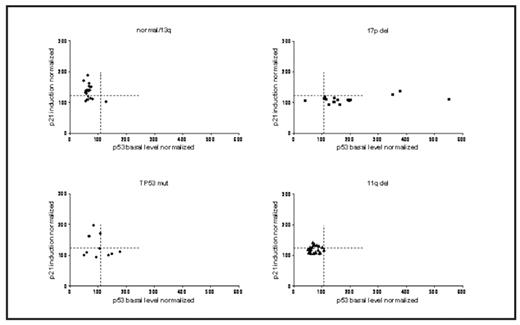Abstract
A central role of the DNA damage response pathway and particularly p53 has been suggested by the prognostic role of 17p and 11q deletions in CLL. In the critical regions, two prominent genes are located that are involved in the cells’ response to DNA damage. Functional assessment of p53 may be of help to more precisely define a subgroup of patients with defects in the DNA damage response pathway. The most commonly used assays include FACS measurement of induction of p53/p21 after DNA damage, induction of p53 by nutlins or the measurement of transcriptional targets of p53 by RT-PCR or MLPA. The growing evidence of the impact of sole TP53 mutations on prognosis led us to analyse the DNA damage response in CLL with special focus on cases with TP53 mutations in the absence of 17p deletion.
We investigated the response to gamma-irradiation (5Gy) in a cohort of 71 CLL cases. We enriched the cohort for the bad prognostic subgroups 17p-, 11q- and TP53 mutation in the absence of 17p deletion in order to precisely dissect the DNA damage response in these subgroups. Levels of p53 and p21 before and after treatment were determined by flow cytometry. Cells were additionally stained with a CD19 antibody to differentiate between CLL cells and CD19 negative cells (T-cells). We developed a strategy to normalize the median values of the CLL cells to the T-cells. Defects in the ATM/p53 pathway can be divided into type A and type B defects that are characterized by an impaired p21 induction and a high or a low basal p53 level, respectively (Pettitt et al. 2001).
Basal p53 levels in 17p-cases (n=15) were significantly higher than for cases with TP53 mutation (P=0.012), 11q deletion (P<0.01) and normal karyotype/13p deletion (P<0.01), respectively). Furthermore, induction of p21 was impaired after irradiation compared to 11q del and normal/13q del (P=0.0066 and P=0.0002). In the cases with a sole TP53 mutation (n=10) we observed higher basal p53 levels compared to 11q- and normal/13q- cases (P=0.044 and P=0.007). The p21 response was heterogeneous, which may be partly explained by the presence of the mutation in subclones. Some cases with TP53 mutation (n=3) showed low p21 induction with low basal p53 levels resembling type B defects. This finding was explained by the presence of splice site and frameshift mutations that prevent formation of p53 protein. These findings suggest that not all cases with TP53 will exhibit the classical type A pattern of expression.
A heterogeneous pattern of p21 induction was observed in patients with an 11q deletion (n=23) and in patients with normal karyotype or 13q deletion (n=23), the induction of 11q deleted cases being significantly lower (P=0.0102). Still, there were 11q deleted cases that responded normally to DNA damage (9/23). These cases can be hypothesized to have retained a functional ATM copy. Similarly, some of the cases with normal karyotype or 13q deletion showed impaired p21/p53 induction (n=6) and the cause for this impairment are under investigation.
This study shows the importance of 17p deletions and TP53 mutations in altering the response to DNA damage in CLL. While this assay provides some insight into the functionality of the ATM/p53 pathway and the thus potentially the treatment response, the clinical and diagnostic value is currently unclear. We observed F-refractory cases showing a rather normal in vitro response to DNA damage. Along the same lines, cases with sole TP53 mutation are partly grouped with the type B defect, suggesting that TP53 mutations cannot be correctly grouped in all cases. Since the induction of p21 was not very strong, the use of other p53 targets could help to define different groups more precisely.
Our findings suggest that the type of TP53 mutation will impact the DNA damage response and potentially lead to misclassification. In how far the heterogeneous pattern of 11q cases and some cases with low risk cytogenetics will help to differentiate biological and prognostic subgroups will need to be assessed in a large independent cohort with homogenous treatment.
Induction of p21 and p53 in CLL with different genetic profile.
Disclosures: No relevant conflicts of interest to declare.
Author notes
Corresponding author


